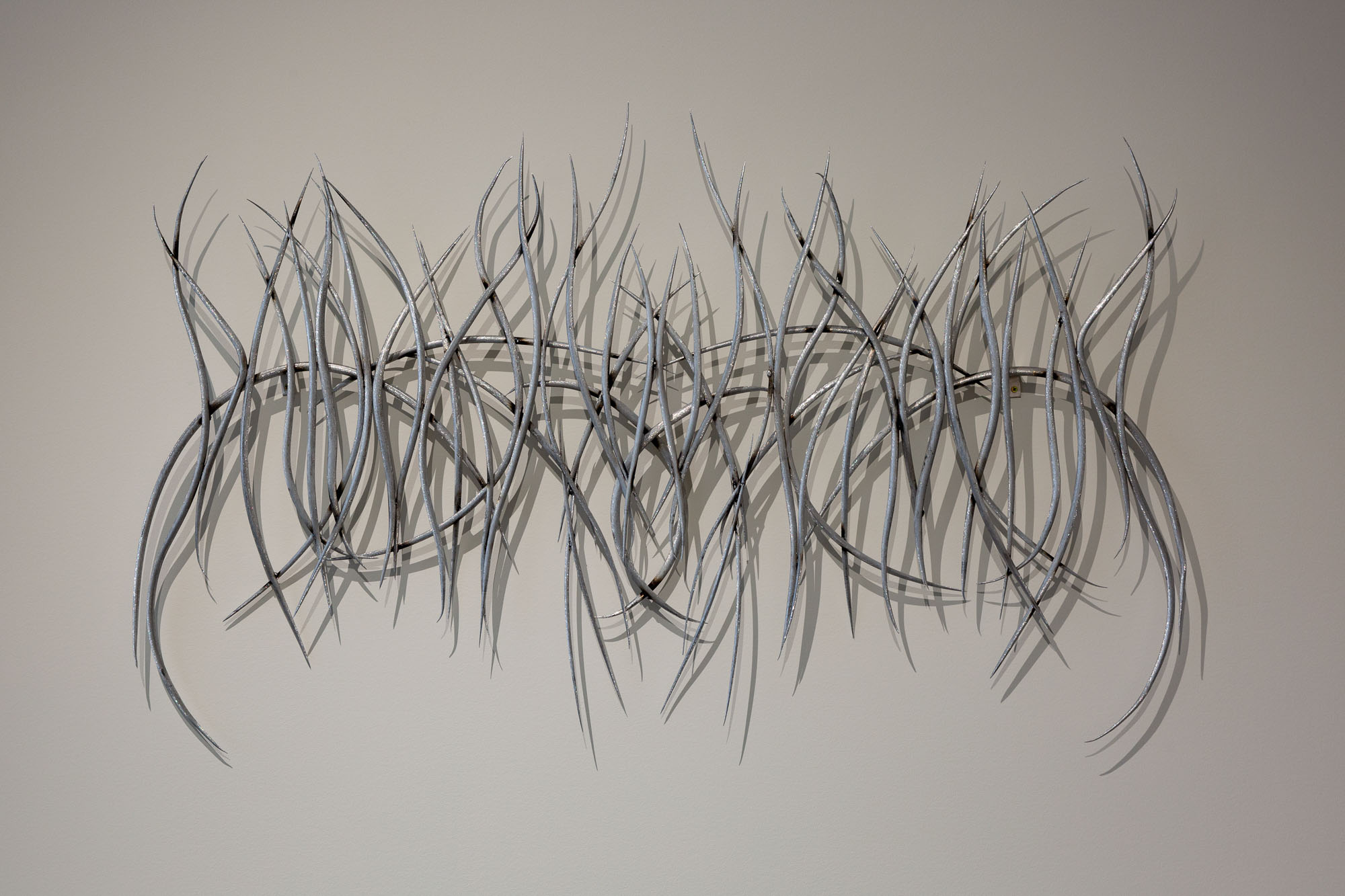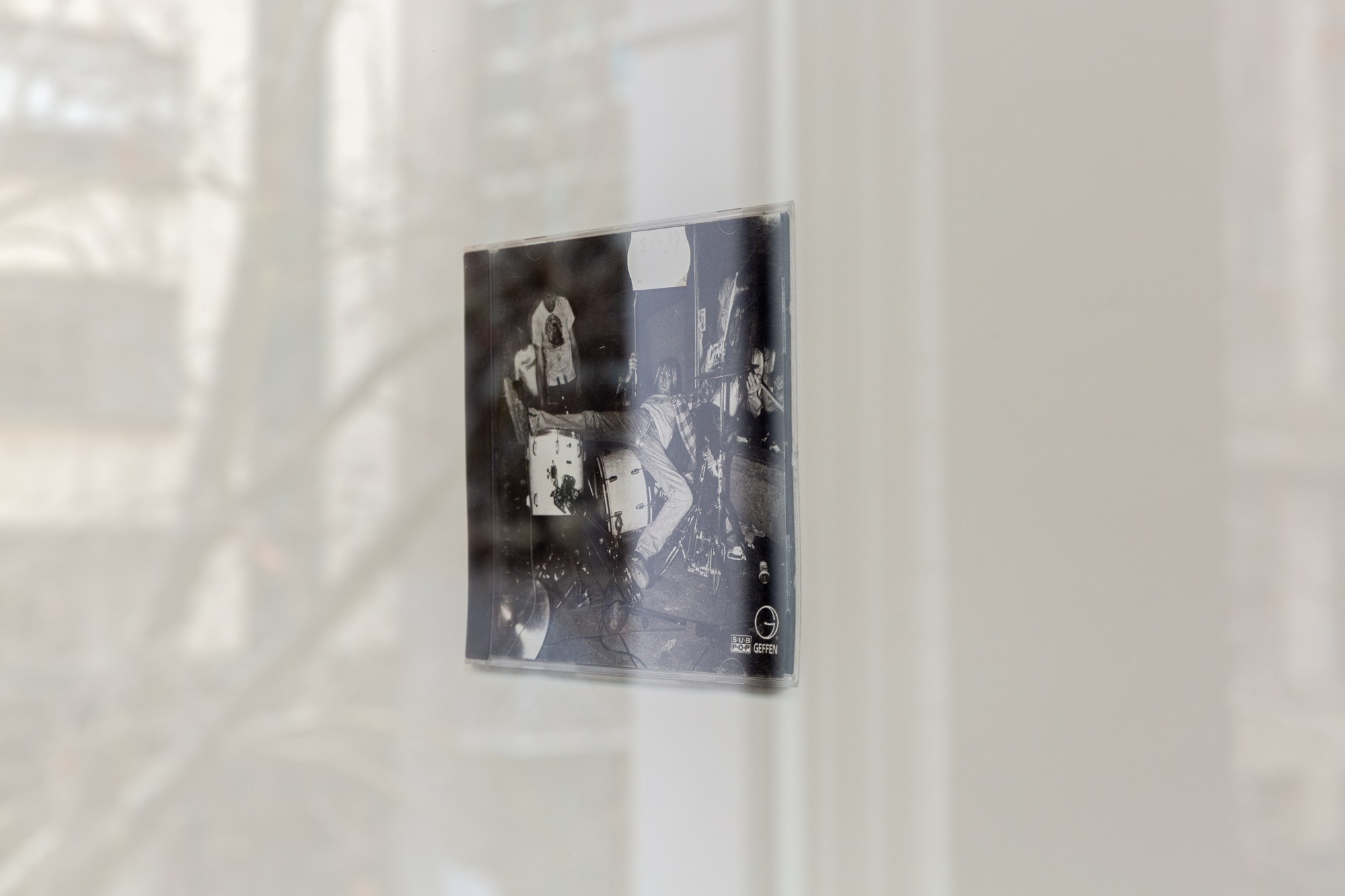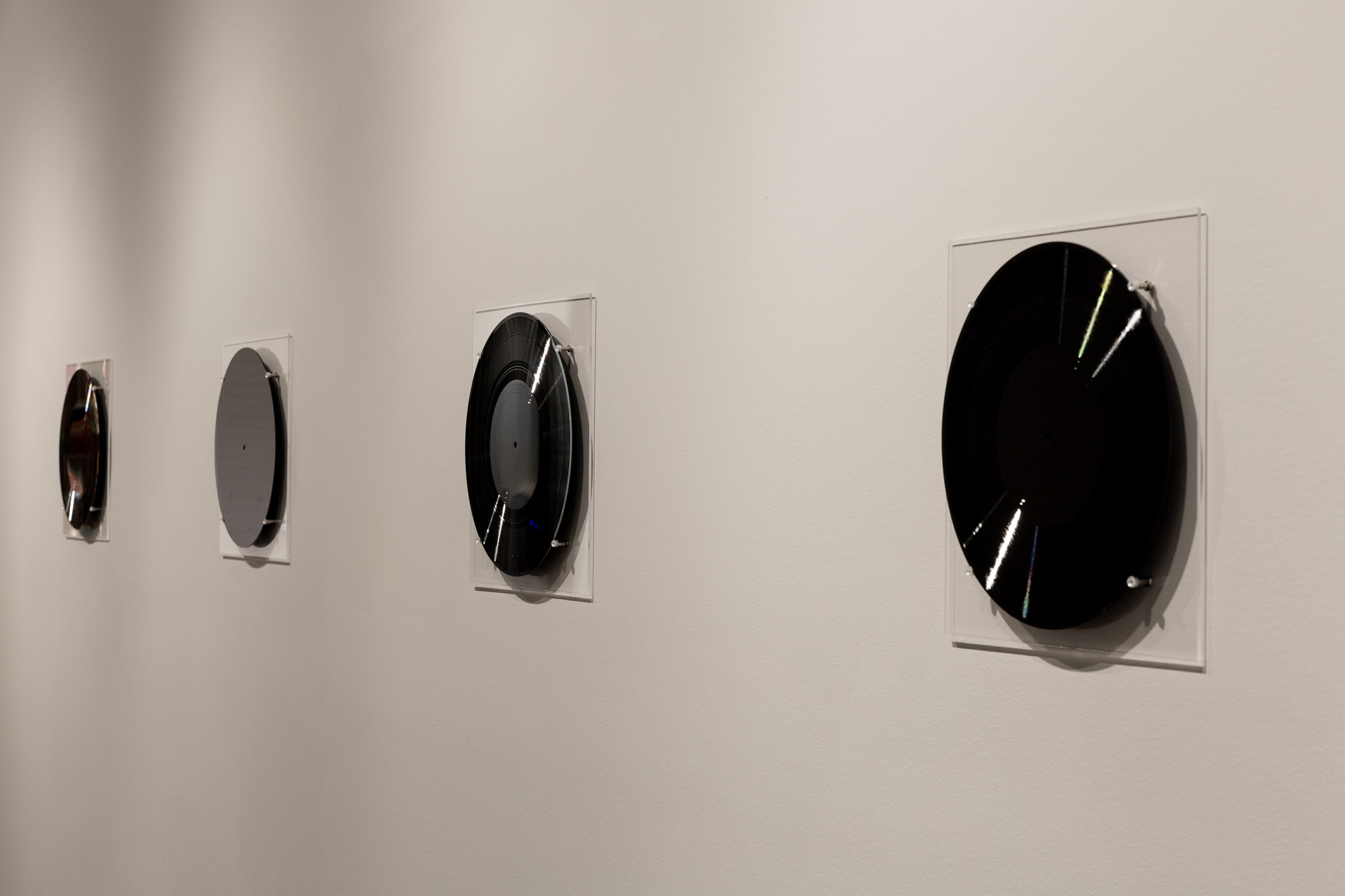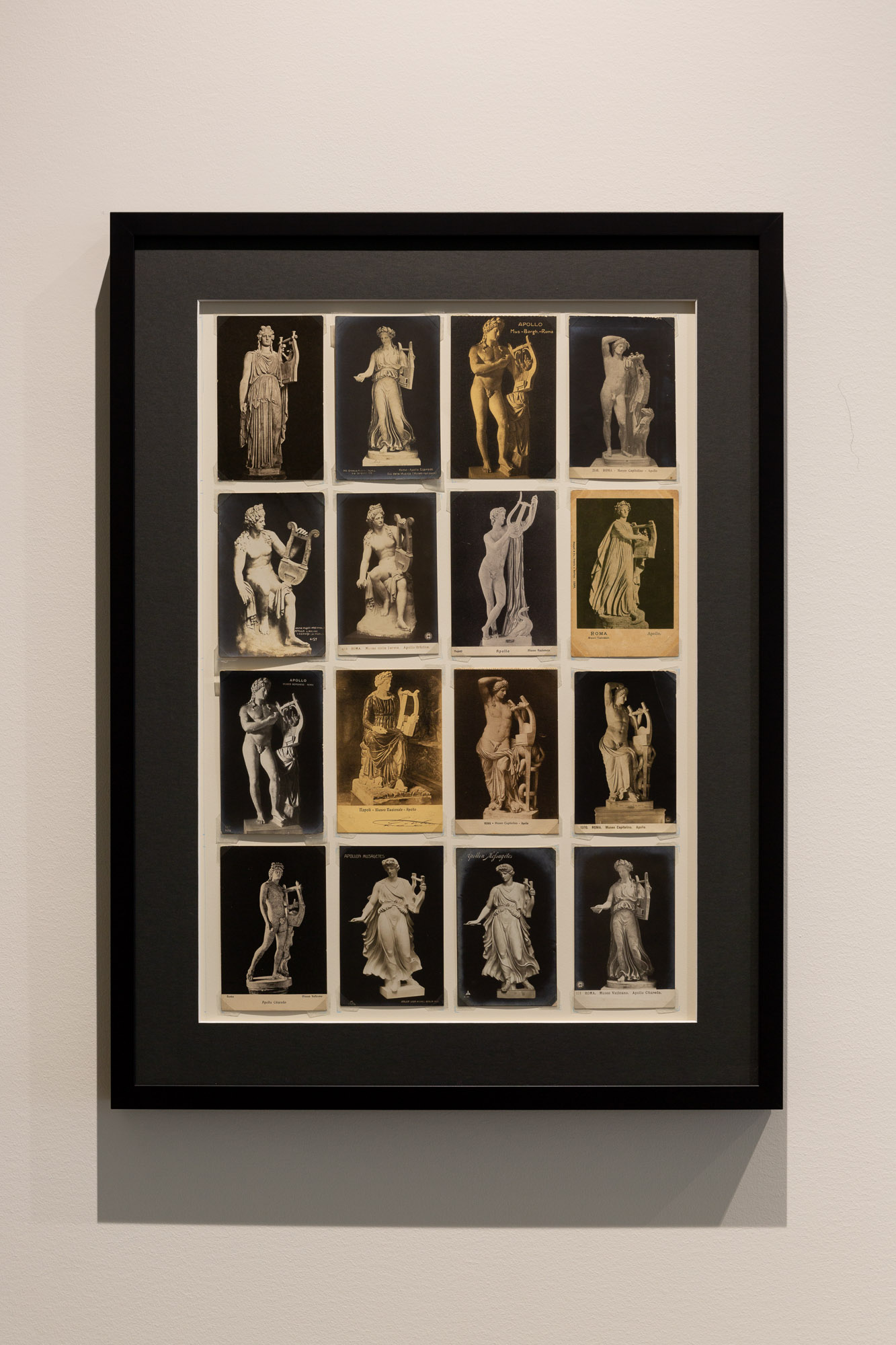Music as Image
Philip Brophy
Music as Image is a modest group exhibition with a directly announced curatorial premise, articulated and produced by two practicing artists — Sean Lowry and Kim Donaldson, here operating under the banner Cūrā8. They are also the team responsible for establishing the new gallery for the exhibition: project8, a short ride in a clean lift to the second floor of a 3-storey white-rendered building in the new-swank west end of Collins Street. It’s a few doors down from Celine (the hobo-chic couturier currently known for taking out multiple pages in Artforum and Frieze). If image is everything (and it is), then Music as Image can be viewed as a micro-reflexive demurring of that adage, here explored through how the musicological can be made manifest within ye olde white cube.
The gallery space is sparely though not sparsely occupied by the work of six artists. They range in scale (from Masato Takasaka’s 1:1 scale reproductions of solitary CD case designs to Karina Utomo and Cūrā8’s floor-to-ceiling video projection of a solo, growling vocal performance), spatiality (from Justene Williams’ free-standing, sculptural prop manipulations to Lucreccia Quintanilla’s spread of post-Rave flotsam and printed T-shirts) and ontology (from Lewis Gittus’ small digital video and lathe-cut vinyl discs to Ilmar Taimre’s serial display of postcard reproductions of Classical antiquities depicting Apollo). True to the exhibition’s rhetorical remit, they are all images of music. And interesting connections can be made between them.

Of course, Music as Image is far from the first exhibition to open this intermedial door. It rides the millennial ankle-splashing waves of Sound Art colliding with foamy celebrations of music videos being revised as Art. It’s a modish terrain full of people who are literally wet behind the ears: visual aesthetes suddenly being exposed to other senses; thematising curators suddenly adopting music’s collaborative function as a radical alternative to Art’s egocentric heroicism; and critics sullenly listening to records like anthropologists looking at natives. I’m relieved and surprised that this exhibition manages to reject those shallow curatorial measures.
Ultimately, each of the works I found to be simultaneously simple in their implied connections to music and complex in the musicological readings they offered. Orthodox rationalisation might intimidate one to damn or praise the works by facetiously taking one side over the other. This is the failure of so much art criticism that suppresses contradictory drives. A more productive tack would be to treat the artworks like a track list of songs: sensorial “objects” whose occurrence is based on repetition and shifting contexts, causing the listener to continually re-evaluate their experiential reading of the song, and finally accept all that is good and bad about it. The great thing about songs is their capacity to transform themselves in the listener’s mind, “growing” on you, “revealing” themselves to you, or inexplicably “resonating” with you despite your rejection of them. Art objects, of course, do this too; but their historical legacy is one of authorial precision and formal perfection, intimidating one into however slightly accepting that Art a priori knows more than you do. For a million reasons, songs are and will forever be positioned on a lower cultural plane that allows the listener a more casual and less controlling relationship in their encounter.
So let’s move clockwise around the space at project8 and check out its playlist. First up is Lucreccia Quintanilla’s installation General Feelings I (2022). It is listed in a playful manner by the artist as “assorted extra-musical objects arranged to form a plausible sculpture, dimensions variable”. It kinda looks skanky, but maybe that’s the point. I hate outdoor music festivals for too many reasons to detail here, but heaps of people love them for the same reasons: their culture of communality, their unleashed social energy, their connection to nature, their meaningful celebration of youthfulness. To me, they are like freeze-dried anthropology experiments in crowd unification, hydrated by sweat, spittle and PET-bottled energy drinks, sonically massaging a crowd into an ecstatic state that in their confusion they’ll remember as being a transcendent experience for years to come. I’m not quoting Lucreccia by any means—even though her position in the vague crossovers of AIRs and alternative club culture ticks these boxes—but I certainly reject the utopian claims by anyone suggesting that bringing people together is one of music’s greatest feats.

General Feelings I’s three emerald green public address speaker bins, a small road case, and the detritus wilfully spread over and between them, constitutes a highly plausible installation, because it replicates the mess made by people having fun. Lavender, mint and hot pink rolls of organza are furled into a wind-strewn suturing of speakers and case, the former topped by black-painted seashells and coral, the latter by a diminutive glitter ball. They symbolically fuse the industrial mechanoid pulsations of Disco with the multi-acculturated worldism of the Caribbean, West Africa and the Americas, nominally referenced through the lightly audible playlist of diasporic multi-generic Reggaeton styles (via Lucreccia’s DJ moniker, General Feelings). Is this installation meant to be elegiac, like a poetic comedown from a heady night, or a deconstructed reverie of belonging to a subculture and all its Mollyfied “inclusivity”? I’m more impressed by the work’s dissolve of those temporary sensory utopias, so beloved across decades by sweating gays, primping queens, drunken punks, mosh pit ragers, gabba speedsters, trance planeteers and rave acolytes. In its unmonumentalism, General Feelings I makes me remember the 1993 Calder Park concert of Guns n’ Roses (Mad Max survivalism in plaid shirts and blue singlets at a fucking speedway) and the 2014 New Year’s Eve public party at Edinburgh Gardens in North Fitzroy (mass bogan Esky bombing of a colonial site unironically beloved of the literati and their precocious children).
From turntabled utopias to amplified dystopias. Masato Takasato’s prints of Nirvana CDs are votive art objects honouring the state of being fucked-up. The art flirts with being so, but the world of Grunge it seems to yearn for definitely was so. The prints’ content is simple enough: a giclée print of the rear inner cover to Nirvana’s CDs of Bleach (released in 1989) and Nevermind (released in 1991). Each print has a ridiculously long title which I’ll now cut-and-paste and which you probably won’t bother fully reading: the former is _Untitled (Double Self Portrait: Bleach) Yes You Kant After Duchamp! … After Courbet’s_, The Origin of the World (L’Origine du monde), 1866, after Duchamp’s Étant donnés (Given: 1. The Waterfall, 2. The Illuminating Gas (Étant donnés: 1° la chute d’eau / 2° le gaz d’éclairage)), 1946–1966; the latter is Untitled (Double Self Portrait: Nevermind) Physical Graffiti (Dixons Recycled Version). The titles perform as neurotic mixtape mashups of the art history lectures artists are forced to attend in order to get their pissy degrees. Both works are cryptically dated (2010, 2014, 2022) and each repro is positioned in a void of white fibre rag paper and encased in an acrylic box. With all that literal and material signage, it must be about art not music, but it does seem to strike a desultory pose, just like a grunge band doing a photo session for a major label release.

The death of Kurt Cobain makes any handling of Nirvana elegiac; but Masato’s work seems to cling to his energy as if he is still alive, still being self-destructive and still being unaware of how prophetic his self-willed annihilation would be. The former print is of the famous photo of Kurt after he “stage dived” in the opposite direction, into Dale Grover’s cheap drum kit, breaking a rib in the process. It’s a typical grunge bodily projection: hurling into its own self-made void while dreaming of Iggy’s radical performativity, but realising that one can’t better that old wiry father figure. Kurt lies sprawled with legs wide apart, hence the cynical quip about Courbet’s L’origine du monde (1866). Marco Fusinato used Courbet’s image in blotchy black and white for the cover of L’Origine/TEMA, containing recorded excerpts of two of his gallery noise gigs, this one for the Polish label Bocian. It’s the “extreme brutal noise” take on acknowledging radical father figures in art, against whom one can never compete. Masato’s play with art is more Cobainian than Courbetian: he treats the CD as an unearthed artefact, applying a conservationist’s zeal that gets moist over carefully reproducing the CD’s printed image with the pricing gun sticker and its distinctive bevelled shape to deter customers peeling it off to replace it with a lower price. The smarmy trick is that Masato is using CDs purchased at Dixon’s Recycled Records (hopefully from the original store in Blackburn). Such a touch is incorporated into both prints, and it grants them a sad, disused status—not because of the ubiquity of post-Napster musical immateriality, but because they remind one of the frail immanence of objects. Contrary to the hand-ringing homilies writers and poets hawk and bark, mythological heroes do die, but physical objects live forever.

Justene Williams’ works in the exhibition signal their relation to music by their titles. To my mind, it’s a limiting tack, akin to when producers and music supervisors profess postmodern elan by forcing songs into a film because of their titles’ blunt relevance to an accompanying scene. Fujiyama Mama (2022) and Hard Headed Woman (2022) are wild Rockabilly psycho-country twangers by the raspy Southern belter Wanda Jackson, the former released in 1958, the latter in 1961. (Japanese New Wave performers culturally flipped it by covering it: Pearl Harbour in 1981 and Frank Chickens in 1984.) I’m talking more about Jackson’s milieu than Justene’s making because the two sculptures stop short of dynamising Jackson’s flaming honky-tonk gal legacy. Maybe they’re not intended to do so, and I could be making too much of the titles. Fujiyama Mama is a gaudy high-school stage prop that riffs on tokusatsu plasticity, a Mount Fuji shape, and a Galaga console alien. Hard Headed Woman assembles two sterile, glitzy store mannequins, one standing and one embedded in a thick half-disc as if sailing a boat. They’re both naked, painted with the hues of a Quantel Paintbox, highly resembling the CD covers of Vaporware artists like Macintosh Plus and Windows 96. They each wear retro digital radios with antennas, scanning the noise emitted from the time warps that energise the field of music today.

As this review opts to favour music over art—to celebrate the breadth of musicological multiplicity over art practices’ tendency toward entropic statement—I choose to split Justene’s dimensionality from its visuality. The former lingers with the tropes of unmonumentalism that infected Contemporary Art some decades back. Her assemblages and installations (or the collapse of the two into an indifferent fusion) riff on Op Shop aesthetics by often resembling the kind of displays that amateur volunteers put together for outer suburban thrift stores. It ticks all the boxes for those afraid to either sculpt with skill or appreciate the fruits of such labour, and as such the work betrays a mute punky stance, regardless of whatever biographical logic is voiced upon the artwork. Fujiyama Mama and Hard Headed Woman thus become more interesting when considering their visuality—the sono-musical skein in which they are attired. They chime with the late 1960s vintage bric-a-brac that arty heads fashioned into living set designs for hippy share-households. Crapified props and painted mannequins appear in appropriately fucked-up stagings from the Carl Schenkel covers for The Mothers Of Invention’s Uncle Meat (1969) and Burnt Weeny Sandwich (1970) to Jim Whiting’s animatronic figures making a mess of things in the music video for Herbie Hancock’s Rockit (1983). This is the world in which I feel Justene’s sculptures here are grounded.
Lewis Gittus is better known by his digi-dance nom de plume Lewis CanCut, specialising in a range of Cumbia, Tropical and Congotronic drum machine patterns that create mobius rhythm loops. His releases are crazy cultural appropriations that are so fake they morph into digital simulacra of musical genres without sampling them. He pushes this strategy into an artwork for this exhibition. Jellied Machines is a digital video looping on a small flat screen, depicting black-and-white solarised threads that gloop and shimmer. It’s essentially an abstract music video for a composition that strips all the blow-up flamingo party paraphernalia from his Lewis CanCut tracks to leave the exposed beats crashing around inside a solipsistic echo chamber of drums programming themselves. Think of it as machine music that has become sentient and now knows it’s having fun while it plays itself. The “art” part of it is extended into a sequence of lathe-cuts vinyl sides I assume are mixes of the track. They’re affixed to clear acrylic squares like rare 12”s on display in a record store. Their silence to me evokes an appropriately posthuman aura, as if this self-programmed drum machine music can really only be listened to by other machines.

Ilmar Taimre’s Apollo Citharoedus – Panels I, II and III (2022) is a total of forty-eight postcards mounted onto three boards, each one depicting Apollo plucking his lyre (or cithara). The images are all Classical marbles, photographed from pre-War museum collections (mostly in Italy) and printed in either black-and-white or faux-sepia duotone. They’re quaint, dating from an era before the Museum Shop controlled the consumerist narrative of viewing art. Ilmar’s choice of Apollo doing his thing resonates with Rock royalty and Metal androgyny. The young god is either as naked as a Rock’n’Roll wrestler or wearing a variation of a goddess dress gathered under his chest and trailing to the ground. But I also see Prince preening himself when I scan these repetitious images, flipping between asexual dressage and oversexed posturing, as if the covers to Prince (1979), Dirty Mind (1980), Parade (1986) and Lovesexy (1988) have been patterned in Warholian serialization.
And finally, the looming screenic image of Karina Utomo, Indonesian-born vocalist in the metal band High Tension and also a solo vocal performer. I don’t buy the press-release tag often used to describe her as an “extreme metal vocalist”. High Tension sound closer to Nirvana and Melvins than anything else, and Karina’s vocalism is rooted more in Metal tropes rather than any expanded experimentalism in vocality. That’s not a putdown of their music: it’s me being irritated by lazy descriptors being applied by uninformed types presuming that they are contributing to musicological sophistication. Mortal Voice (2022) is a video of Karina performing solo. It’s a curious concoction, being a recording of her improvising some guttural vocal expulsions and striking some godess-like bodily poses, filmed in a live one-take in the project8 gallery space. She thus appears as a mirage in situ, transmogrified by being slightly stretched horizontally and enlarged moderately. She is simultaneously there and not there. The aurality of her presence arises from her processed voice—a sound dominating the gallery space, but due to being slowed-down and featuring inhalation pauses, it doesn’t interfere with the other artworks. This is no small feat to pull off. Most contemporary art spaces mess this up time and again and seem to never learn from their deafness.

Yet an intriguing ambiguity haunts Mortal Voice. The slowing down of the video and its synchronised audio on the one hand pays visual lip service to the lowest form of Video Art aestheticism—that things magically look “beautiful” when slowed down, thank you Bill Viola. I don’t think it adds anything to Karina’s performance, and it distracts from the otherwise corporeality of her muscles and hair, flexing and flicking as she grasps the mic and whips its cord. The audio I also feel is a disservice: it is neither distorted nor destroyed. It simply simulates a slowed down effect through its time-stretching. But on the other hand, this spectre of a woman coughing up demonic fur balls becomes an android apparition, like a gender-swapped black angel summoned from early 1990s Jungle time-stretched vocal samples (Dead Dred’s ‘Dred Bass’ being the sonic ur-text with its Caribbean patois transfiguration). Might she be the spirit of Music as Image? Like a digital talisman, her voice accretes General Feeling’s Reggaeton callouts, Kurt Cobain’s nicotined anguish, Wanda Jackson’s honky-tonk scream, Lewis CanCut’s machinic dialogue and Apollo’s lyric idylls. When I think about the artworks’ interconnections, I hear a chorus of voices, each inviting me into its own portal where the visual is overwhelmed by the sonic.
Philip Brophy writes on art among other things.


